The new "Vul". Special self-loading pistol PSS-2
Recall, the MSS pistol was developed in the early eighties of the last century by designers of the Central Scientific Research Institute of Precision Engineering. This weapon was intended for special forces who need silent shooting systems. Taking into account the experience and using the existing developments, the original appearance of the rifle complex was formed as part of a self-loading pistol and a special cartridge.
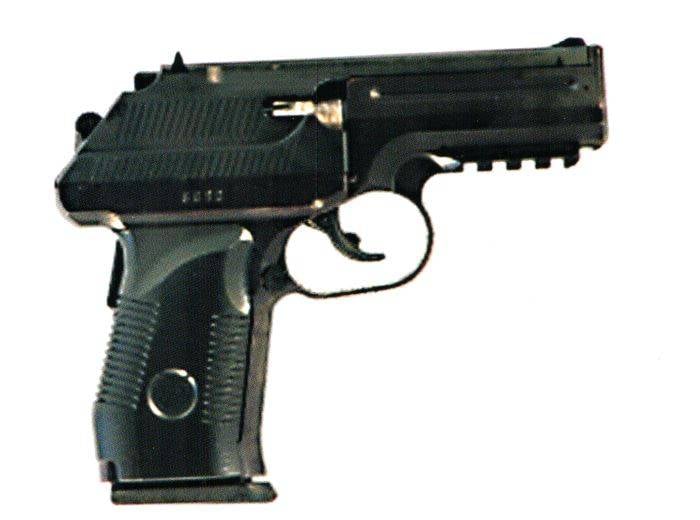
General view of the gun PSS-2. Photo Modernfirearms.net
It is known that when fired, the main sources of noise are a flash at the muzzle of the barrel and a bullet flying at supersonic speed. In the PSS project, these factors were eliminated with the help of a special cartridge, built according to a scheme with a cut-off of powder gases and accelerating the bullet to subsonic speeds. Not a bullet, but a special piston-pusher contacts with the powder sample inside the liner. When powder gases form, it shifts forward and pushes the bullet out of the weapon. At the same time, the pusher itself does not leave the sleeve and locks the hot gases in it, preventing them from going out and forming a sound wave.
One of the objectives of the project VSS "Vul" was to reduce the size of the gun. Such goals have been successfully achieved, so that the noiseless weapon in size does not exceed most of the modern self-loading pistols. It should be noted that when comparing the PSS and any other pistol with a noiseless firing device, the advantage in size remains unconditionally with the specialized system.
According to various sources, MSS pistols for a long time were used by various special units of the armed forces and security forces. Subsequently, there was a proposal to upgrade this sample. With all its advantages, "Vul" had some drawbacks, to some extent worsening its characteristics and capabilities. A few years ago, a proposal for a deep modernization of the existing pistol led to the emergence of a new model of weapon. The updated gun received the designation PSS-2.
It should be noted that in the framework of the new project it was again about creating a complex in the form of a pistol and a cartridge with special characteristics. Some of the basic characteristics were proposed to be enhanced by using a new cartridge, which received the designation SP-16. According to its scheme, this munition repeats the older SP-4, which was used with the Vul pistol, but has a number of important differences with which the required characteristics are achieved.
The 7,62x43 mm SP-16 cartridge differs from the old 7,62x40 mm SP-4 cartridge with an elongated sleeve. This allowed to a certain extent to increase the size of the powder charge, which led to an increase in the initial velocity of the bullet from 200 to 300 m / s. Such a revision of the cartridge led to a noticeable increase in its fighting qualities, but at the same time it allowed maintaining the subsonic speed of the bullet, excluding the appearance of a shock wave.
The cartridge is equipped with a cylindrical steel bullet having a smaller diameter in the head. On the small cylinder is a copper lead belt. In order to improve the penetration characteristics, the bullet has a pointed head in the form of two converging flat surfaces, like a chisel. Because of this, at a distance of 25 m, it is able to penetrate the 2 class body armor. When firing at the unprotected manpower of the enemy, it is possible to obtain an effective range of up to 50 m.
The use of a new cartridge and other requirements have led to a noticeable renewal of the appearance of the pistol in comparison with the basic design. Changes in the design allowed the use of a new cartridge, characterized by large dimensions and increased power, to improve the basic characteristics, as well as to simplify operation due to improved ergonomics and other means of controlling the trigger mechanism.
In terms of overall architecture, the new PSS-2 pistol is similar to its predecessor. Nevertheless, even in the appearance of the two samples there are noticeable differences. As before, the basis of the design is a metal frame, in front of which is placed a rifled barrel of medium length, behind it are placed automation mechanisms, including a movable casing of the shutter. Under the main part of the frame there is a trigger bracket and a shaft handle for installing the magazine. With the exception of some original features borrowed from the previous project “Vul”, the overall layout of the pistol of the new model corresponds to the modern “traditions”.
The weapon uses automation based on a free gate, supplemented by a movable chamber. The shutter is connected to the movable casing and has its own return spring, placed on the guide rod in the upper part of the casing. Under the barrel is the chamber's own return spring. The back of the frame accommodates the parts of the firing mechanism and the means for feeding cartridges when recharging. PSS-2 pistol, like its predecessor, does not have a casing of the bolt that runs the entire length of the weapon. Because of this, a separate hole for the ejection of the sleeves is missing. The cartridge case must fly through the window formed when the casing is retracted.
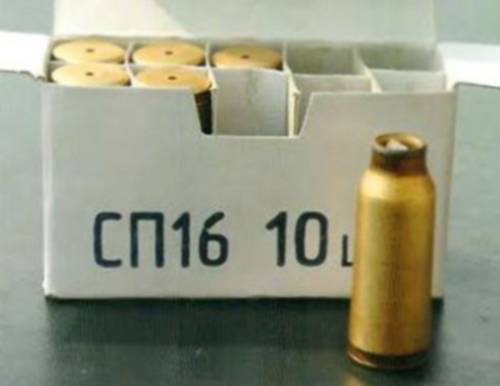
Cartridges SP-16. Photo Armoury-online.ru
The trigger mechanism of the pistol is built according to the hammer scheme with self-cocking. The back of the rocker trigger protrudes beyond the arms. In the initial project of the PSS "Vul" the design of the trigger was created on the basis of the corresponding parts of the pistol PM. The upgraded special pistol received a trigger mechanism based on the corresponding CP-1M pistol assembly. Cocking mechanisms before the shot is made when you press the trigger. Like the existing serial pistol, the special PSS-2 received only an automatic fuse. The USM is unlocked by simultaneously pressing a button protruding from the back surface of the handle and the lever on the trigger.
The self-loading special gun of the second model uses the traditional power supply system for such a weapon. Cartridges are stored in detachable box-shaped stores placed in the receiving shaft of the handle. The ammunition is fed to the loading line using a spring and a pusher. The magazine is held in the handle by a latch controlled by a movable bottom cover.
For aiming the gun PSS-2 received unregulated aiming devices. On the front of the rolling casing, near the muzzle of the trunk, there is a front sight, which is part of its design. Slot with slot, located in the back of the gun, also made at the same time with a movable casing. Any means for adjusting the sights are not provided due to the limited range of fire. If necessary, the shooter can equip the gun with the desired additional systems, such as a laser pointer or a flashlight. For their installation on the frame under the barrel, an integrated standard profile bar is provided.
The new project included some measures aimed at improving ergonomics. The PSS pistol had a specific wide grip of low height, which caused the shooters to complain due to the low comfort. Despite the use of a longer cartridge, the PSS-2 managed to develop a more comfortable grip, in its proportions similar to the aggregates of other modern pistols. As before, a trigger guard is placed in front of the handle.
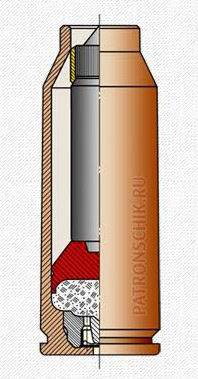
Scheme of the special cartridge. Figure Modernfirearms.net
The use of a new cartridge, characterized by its large size and increased power, led to corresponding consequences in the context of the dimensions of the weapon itself. PSS-2 has a length of 190 mm and weight (without cartridges) - 1 kg. For comparison, the length of the base "Voula" is only 170 mm, weight - 0,7 kg. At the same time, as can be judged from the available data, in terms of ergonomics, the new model of special weapons is not too different from the old ones.
The PSS-2 pistol received automation based on the design of the PSS product. This led to the preservation of the basic principles of the weapon. It should be noted that the rejection of some of the ideas of the previous project simply would not allow minimizing the noises made by the weapon when fired.
The process of preparing a pistol of a new model for firing is standard for such weapons. The six-round SP-16 six-round magazine is fitted into the shaft of the handle and secured in place with a latch. Next, the shooter must pull back the casing back. Reaching the rearmost point, the bolt gets the opportunity to hook the upper cartridge and, returning forward under the action of the return spring, send it to the chamber. After that, the weapon is ready to fire.
The correct grip of the weapon and pressing the trigger with the required effort leads to unlocking the trigger mechanism. Pressing the trigger cocks the trigger and then releases it. Shot occurs. Powder gases inside the liner begin to act on the piston-pusher, which, in turn, knocks out a bullet. Moving forward, the piston rests against the tapering part of the liner and locks the gases inside it. When a bullet enters the barrel and the lead belt engages with rifling gas energy and the piston begins to push the cartridge case with the chamber and the bolt back. The bolt and chamber are retracted, compressing their own return springs.
After some distance, the chamber stops. At the same time, a gap is formed between its front part and the breech breech, through which atmospheric air enters the barrel bore. Due to this, due to the absence of powder gases, when a bullet leaves the barrel, air does not get into the barrel bore, which can cause additional loud pop. After braking the chamber, the shutter continues to roll back. In this case, the parts interact through a special thrust, thanks to which a smooth deceleration of the bolt occurs without impact in the extreme rear position. After braking, the bolt, set in motion by the return spring, moves forward, sends the next cartridge and returns the chamber to the most forward position. After that, the weapon is ready for a new shot.
According to reports, the main work on the self-loading special pistol PSS-2 was completed at the end of the last decade. The weapon passed all the necessary checks and was able to interest potential customers. In 2011, the gun was adopted by special units of the Federal Security Service. The exact list of operators and the tasks they solve are, for obvious reasons, unknown.
The recent upgrade of the silent pistol is of interest for a variety of reasons. Firstly, the PSS Vul pistol at one time became a real sensation, which is why any attempts to further develop it, by definition, cannot fail to attract the attention of specialists and the general public. The second reason for interest lies in improving the basic characteristics achieved with the help of an improved cartridge and a modified design of the gun itself.
The third most interesting feature of the project PSS-2 can be considered a change in its purpose. The existing "Vul", which has been in service since the early eighties, was in fact a specialized system for solving special problems. In terms of its main characteristics, the pistol for the cartridge SP-4 lagged noticeably behind “conventional” weapons, which had clear consequences from the point of view of operation. The new PSS-2 in its firing characteristics, obtained with the help of a more powerful special cartridge SP-16, came close to other army pistols. Thus, with certain limitations and reservations, the PSS-2 can be not only an addition to regular small arms, but also a pistol suitable for independent use in special and “ordinary” situations. However, the full replacement of existing samples with new PSS-2, of course, is out of the question.
The idea of the cut-off of powder gases in the liner, proposed several decades ago and successfully implemented in various small arms projects, was not forgotten. Not so long ago, it received a new development, as a result of which the PSS-2 pistol appeared. This weapon was created taking into account the experience of the previous product "Vul" and has a number of important differences. A deep modernization of the existing pattern based on interesting ideas has already led to positive consequences. Special units of the security forces received an improved model of weapons with special capabilities.
On the materials of the sites:
http://modernfirearms.net/
http://armoury-online.ru/
http://zonwar.ru/
http://tvzvezda.ru/
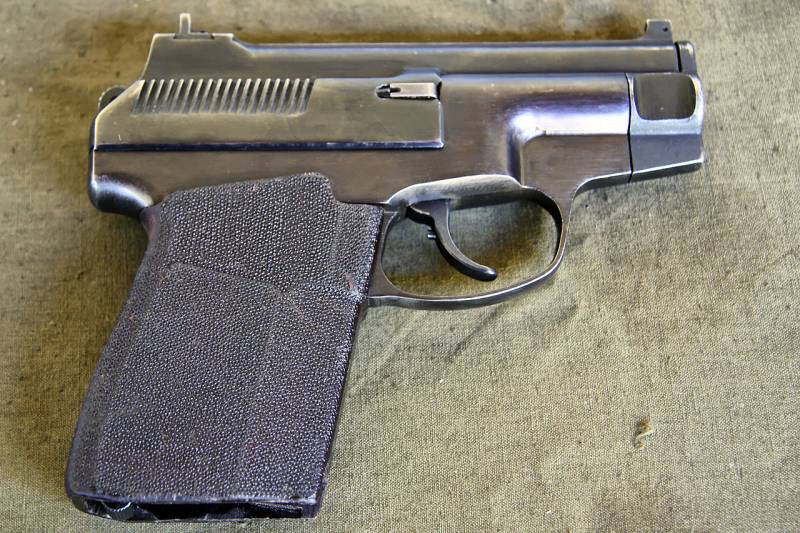
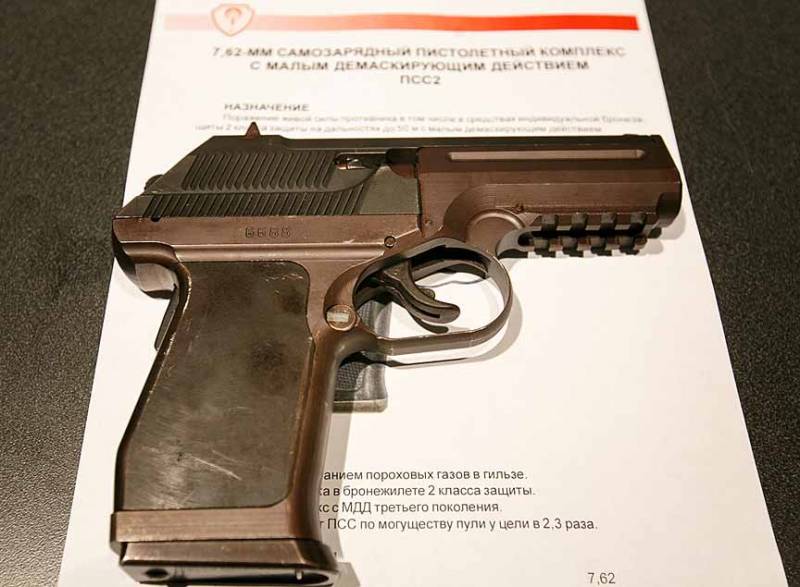
Information